ISSN ONLINE(2319-8753)PRINT(2347-6710)
ISSN ONLINE(2319-8753)PRINT(2347-6710)
Ponni M Mohan.1, Shamnamol G. K.2
|
| Related article at Pubmed, Scholar Google |
Visit for more related articles at International Journal of Innovative Research in Science, Engineering and Technology
Whey is a byproduct which contains nutritional value added proteins like, α-Lactalbumin, α-Lacto globulin. Although several possibilities for cheese-whey exploitation have been assayed, approximately half of world cheese-whey production is not treated, but is discarded as effluent. It is necessary to develop an effective and environmentally benign aqueous two phase system (ATPS) for the recovery of value added cheese whey proteins. Recently ATPS have drawn more interest among the other separation processes, particularly in the field of biotechnology due to the mild conditions of the process, short processing time, and ease of scale up. In order to design a two stage ATPS process the effect of system parameters such as pH, types and the concentrations of the phase forming components , temperature, etc., on partitioning of proteins were addressed a view to maximizing recovery. In the present study, partitioning of whey proteins from dairy effluent by using polyethylene glycol and sodium sulphate was done. The results showed that PEG-4000 at 50% concentration and salt at 40% concentration under conditions of pH 5.4 and temperature 35ºC will give maximum yield and partition coefficient.
Keywords |
| Cheese whey, aqueous biphasic system, Extraction, dairy effluent, Protein recovery. |
INTRODUCTION |
| Whey protein is a mixture of globular proteins isolated from whey, the liquid material created as a by-product of cheese production. Some studies have suggested that whey protein may possess anti-inflammatory or anti-cancer propert. The effects of whey protein on human health are of great interest and are currently being investigated as a way of reducing disease risk, as well as a possible supplementary treatment for several diseases such as heart disease, cancer and diabetes. Whey protein is typically a mixture of beta-lactoglobulin (~65%), alpha-lactalbumin (~25%), and serum albumin (~8%), which are soluble in their native forms, independent of pH. Whey is an abundant source of branchedchain amino acids (BCAAs), which are used to fuel working muscles and stimulate protein synthesis. In particular, leucine plays a key role in initiating the transcription of protein synthesis. When leucine is ingested in high amounts, such as with whey protein supplementation, there is greater stimulation of protein synthesis, which may speed recovery and adaptation to stress (exercise). Another studies suggested that large amounts of whey protein can increase cellular glutathione levels. |
| Whey proteins were usually obtained by a combination of membrane concentration and chromatographic methods (i.e. ionic exchange, affinity and radial flow chromatography). Although these techniques are very effetive in partitiong the proteins they have some disadvantages i.e, they may induce the denaturation of proteins. Partitioning in aqueous two phase systems (ATPS) is a good alternative method to be employed as a first step purification. Many studies have been carried out using this technique for the separation of various products. Aqueous two phase system (ATPS) is an alternative method for separation of biomolecules which reduces number of steps and thus reduces the overall cost. It is a liquid – liquid extraction method which makes use of two aqueous phases. The two aqueous phases consists of two wa-ter-soluble polymers or a polymer and a salt. It is a potential technique that has applications in the field of biotechnology for the separation and purification of biological materials such as proteins, enzymes, nucleic acids, virus, antibodies and cell organelles. The simple process and low cost of phase forming materials allow this method for largescale purification also. ATPS is used for the extraction of biomolecules due to their high water content which will help to prevent the denaturation of these biomeolecules. [1] |
| Polyethylene glycol (PEG) is used as one of the phase forming polymers in ATPS because it is available at low cost and forms a two-phase system with other neutral polymers as well as salts. Also PEG has the ability to enhance the refolding of proteins. Because of the high cost and high viscosity of the polymer/polymer system, the aqueous two phase polymer/salt systems are preferred over the polymer/polymer systems. Most commonly used salts were phosphates, sulphates, carbonate and citrate. Different studies shown that various factors will affect the partitioning of proteins into two phases such as such as the concentration of phase forming components, molecular weight of PEG, type of salt used for phase formation, pH and temperature of the system. |
| In the present study we have evaluated the effect of various salts, concentration of PEG and salts, temperature and pH conditions for the effective partioning and yield of proteins. |
MATERIALS AND METHODS |
| A. Materials |
| Analytical grade (Merck) polyethylene glycol with a molar mass average of 4000 and 6000, sodium sulphate, sodium carbonate and sodium citrate were used. Bovin serum albumin (BSA),alkaline copper reagent, folin’s ciocalteous reagent and cheese whey. Cheese whey is prepared by heating milk to 80 °C and appropriate amount of lime water is added (500 ml of milk require 20 ml of lime water). The prepared cheese whey is kept in refrigerator for storage. |
| B. Aqueous two phase system preparation |
| Prepare appropriate weight percentage of polyethylene solution(50%,40%), potassium phosphate solution, sodium sulphate solution and sodium chloride solution(30%,35%,40%). Aqueous two phase systems were prepared by mixing suitable amounts of PEG and given salts. Then centrifuge all the tubes at 15000 rpm for 10 minutes for separation in to two phases. The protein concentration in the individual phases was determined by the method of folin’s lowry method. Calculate the partition coefficient and yield by using following equations. [2] |
| Partition coefficient, K= C(top)/C(bottom) |
| C (top) - concentration of protein in the top phase. |
| C (bottom) - concentration of protein in the bottom phase. |
| Yield, |
| YT= VTCAT/V0C0 |
| VT- Top phase volume. |
| CAT- Concentration of protein in the top phase. |
| V0 -Total volume. |
| C0 -Total concentration. |
| C. Estimation of protein by folin’s lowry method |
| Graded volume of standard bovine serum albumin was pipette out in to a series of test tubes and then 0.4ml of top and bottom phase was pipette out into test tubes and making up to 1ml using distilled water. A blank was simultaneously prepared by taking 1ml of distilled water. 5ml of alkaline copper reagent was added to all tubes mixed well and incubate at room temperature for 30 minutes. Then add 0.5ml of folin’s ciocalteous reagent and incubate for 15 minutes. Blue colour developed was read at 620nm. |
| A graph was plotted with concentration of BSA along X-axis and optical density on Y-axis. Then concentration of protein in the top and bottom phase was calculated from the graph. |
RESULT AND DISCUSSION |
| In the present study of, partition of cheese whey using different salts, sodium sulphate, sodium carbonate, and sodium citrate and 50% PEG based aqueous two phase system. The system was studied at different conditions. The effect of different salts, salt concentration, polymer concentration, molecular weight of PEG, pH, and temperature on partition coefficient and yield was studied. |
| A. Effect of different salts on yield and partition coefficient |
| In this study 3 salts such as sodium sulphate, sodium carbonate and sodium citrate(40%) and 50% polyethylene glycol were used for phase separation studies. The yield and partition coefficient was found out using the above discussed equations. It has been found that sodium sulphate give maximum yield and partition coefficient as compared to other salts. Fig 1 and 2 shows that sodium sulphate gives maximum yield and partition coefficient respectively. |
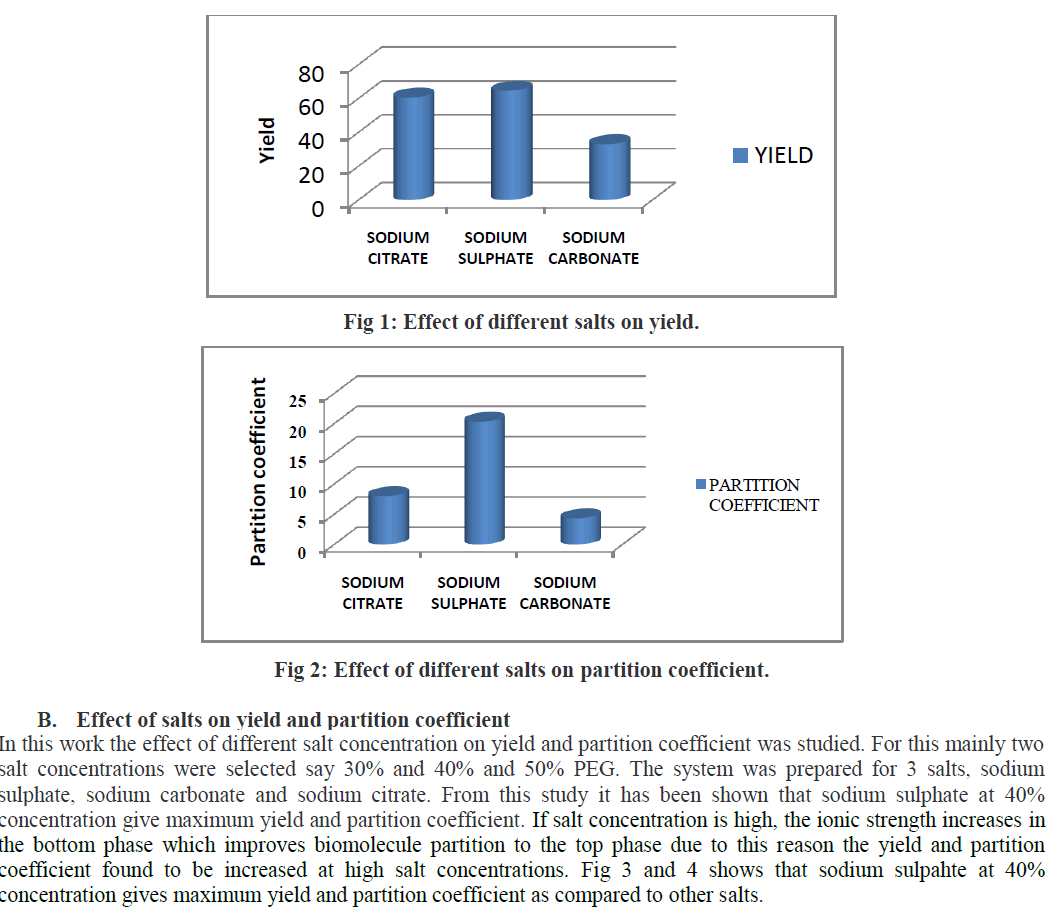 |
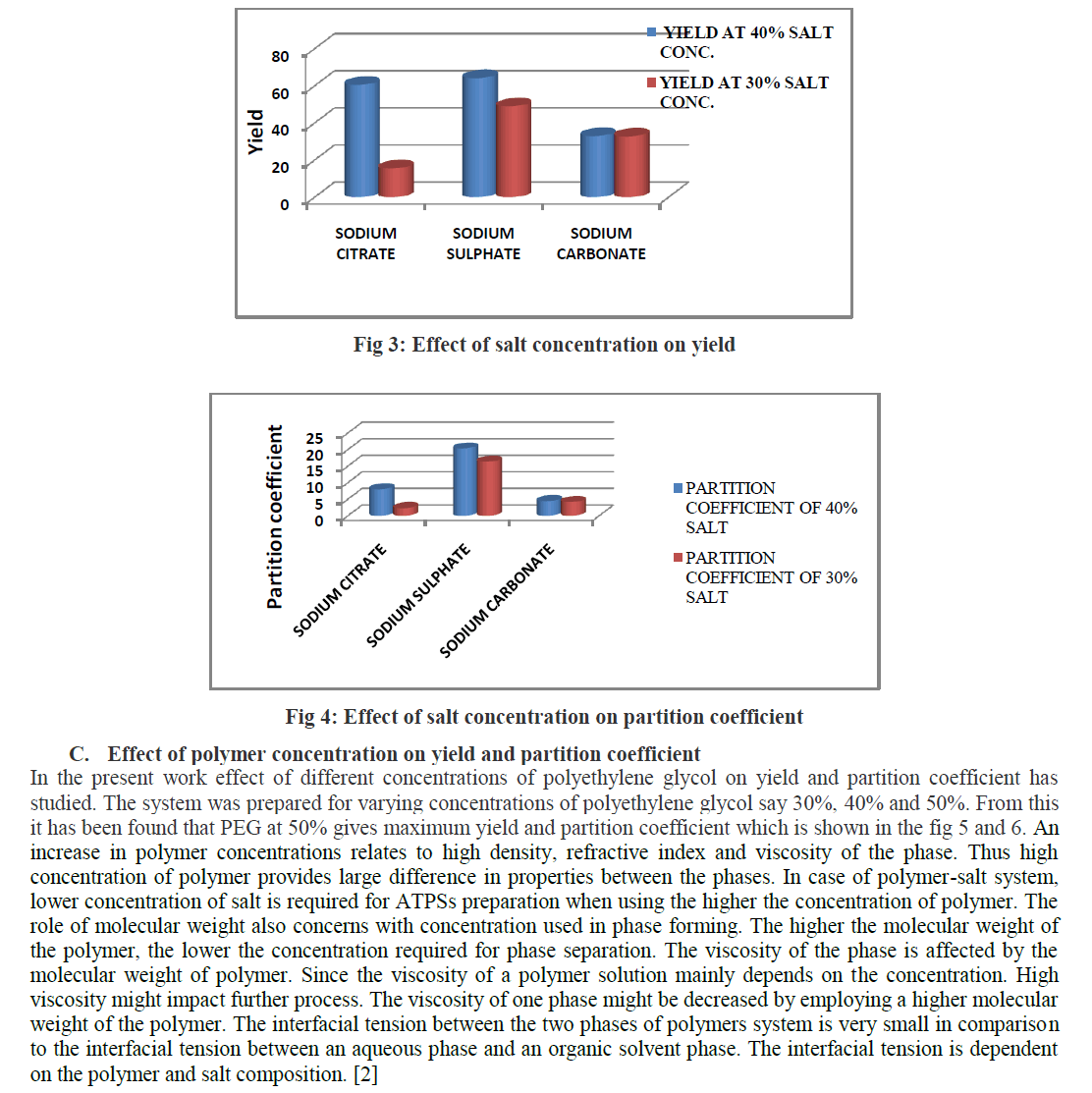 |
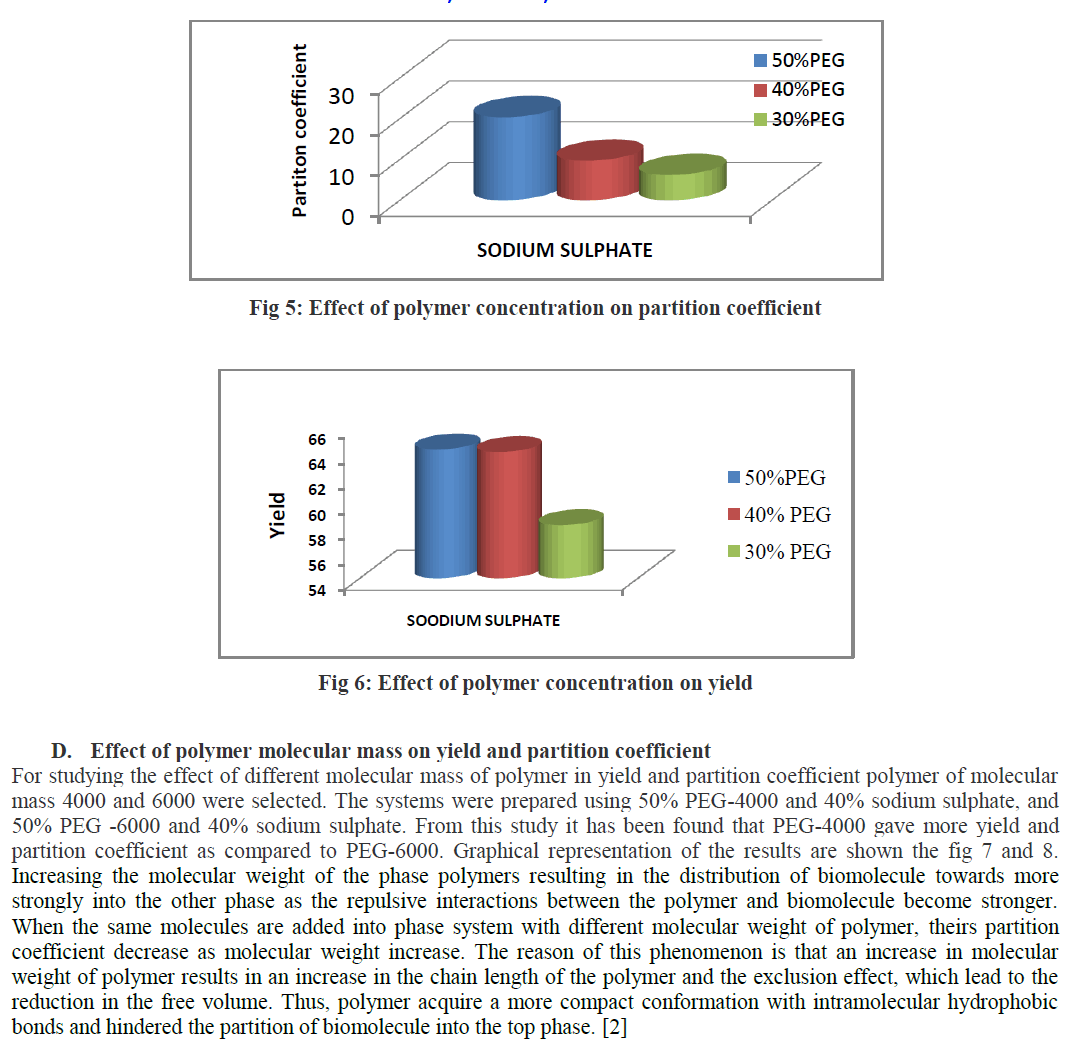 |
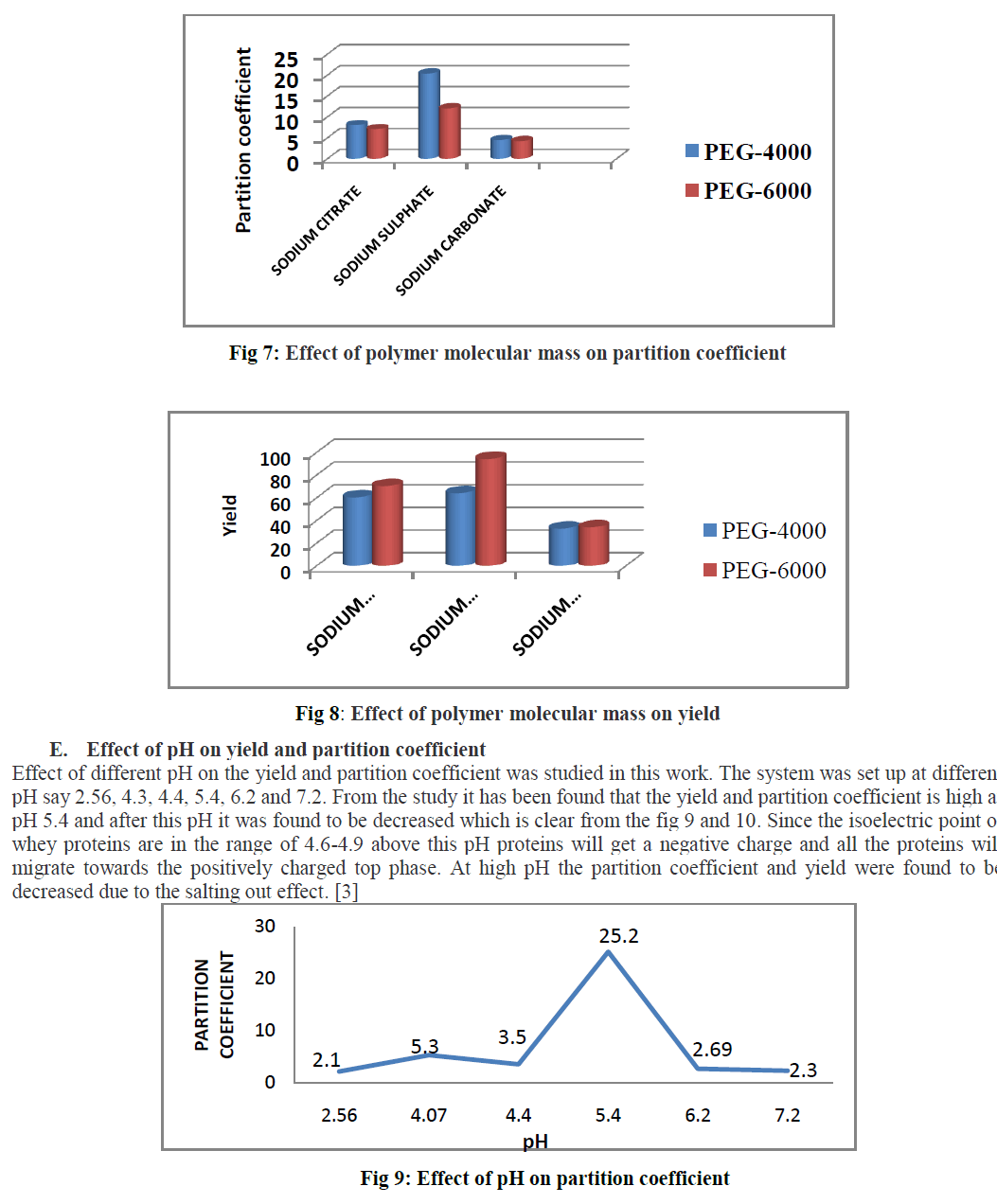 |
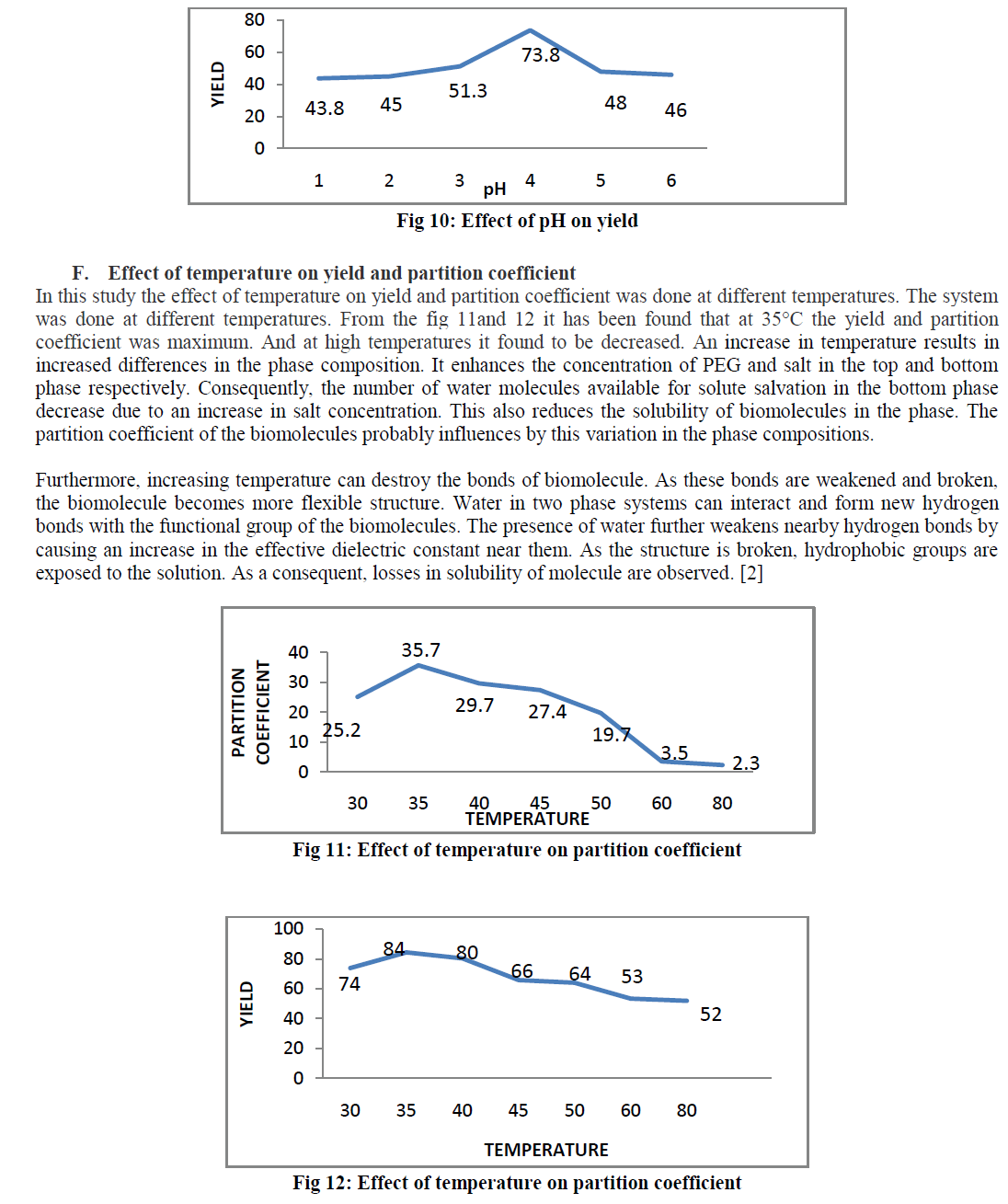 |
CONCLUSION |
| In the present study, partitioning of cheese whey was carried out in PEG-sodium sulphate and water based aqueous two-phase systems. The influence of salt concentration, polymer concentration, polymer molecular weight, pH, and temperature was studied. The yield and partition coefficient were evaluated for each case. From this work we concluded that PEG-4000 at 50% concentration and salt at 40% concentration under conditions of pH 5.4 and temperature 35ºC will give maximum yield and partition coefficient. In future studies the results can be validated by using a software mini-tab. |
References |
|